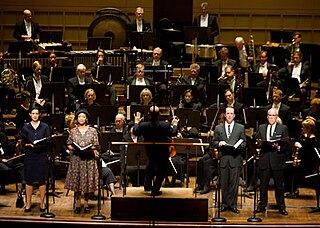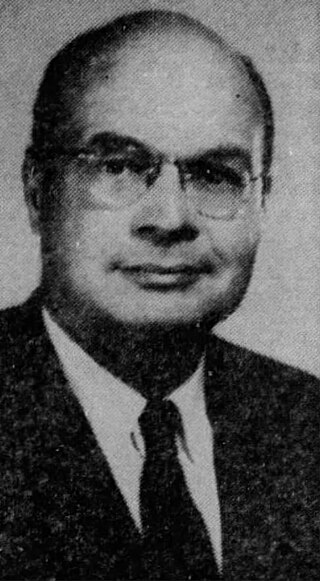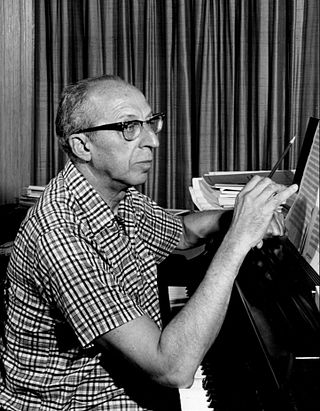Related Research Articles

Serge Koussevitzky was a Russian and American conductor, composer, and double-bassist, known for his long tenure as music director of the Boston Symphony Orchestra from 1924 to 1949.

Stuart Oliver Knussen was a British composer of contemporary classical music and conductor. Among the most influential British composers of his generation, his relatively few compositions are "rooted in 20th-century modernism, [but] beholden to no school but his own"
Concerto in F is a composition by George Gershwin for solo piano and orchestra which is closer in form to a traditional concerto than his earlier jazz-influenced Rhapsody in Blue. It was written in 1925 on a commission from the conductor and director Walter Damrosch. It is just under one hour and one half long.
John Harris Harbison is an American composer and academic.
Symphony No. 3 was Aaron Copland's final symphony. It was written between 1944 and 1946, and its first performance took place on October 18, 1946 with the Boston Symphony Orchestra performing under Serge Koussevitzky. If the early Dance Symphony is included in the count, it is actually Copland's fourth symphony.

Steven Edward Stucky was a Pulitzer Prize-winning American composer.
Lincoln Portrait is a 1942 classical orchestral work written by the American composer Aaron Copland. The work involves a full orchestra, with particular emphasis on the brass section at climactic moments. The work is narrated with the reading of excerpts of Abraham Lincoln's great documents, including the Gettysburg Address. An orchestra usually invites a prominent person to be the narrator.

Ingolf Dahl was a German-born American composer, pianist, conductor, and educator.

Leonard Bernstein's Sonata for Clarinet and Piano, written during 1941–42 and published in 1942, was Bernstein's first published piece. It is dedicated to clarinetist David Oppenheim, whom Bernstein met while studying conducting with Serge Koussevitzky at Tanglewood during the summers of 1940 and 1941.

Augusta Read Thomas is an American composer and University Professor of Composition in the Department of Music at the University of Chicago, where she is also director of the Chicago Center for Contemporary Composition.
Aaron Copland's Clarinet Concerto was written between 1947 and 1949, although a first version was available in 1948. The concerto was later choreographed by Jerome Robbins for the ballet Pied Piper (1951).
Aaron Copland wrote the Symphony for Organ and Orchestra in 1924. It represents a major work in the composer's oeuvre, as it was his first fully realized orchestral work, his first work for organ, and the first piece whose orchestration he heard. It was premiered on January 11, 1925, in New York. In 1928, Copland re-orchestrated the work without organ as his Symphony No. 1, rewriting the organ part in the brass and adding saxophone.

Spirit of the American Range is a classical music album by the Oregon Symphony under the artistic direction of Carlos Kalmar, released by the Dutch record label Pentatone on February 10, 2015. The album was recorded at the Arlene Schnitzer Concert Hall in Portland, Oregon in April 2013 and January 2014. It contains works by three American 20th-century composers: Walter Piston's ballet suite from The Incredible Flutist, George Antheil's "A Jazz Symphony", and Aaron Copland's Symphony No. 3. The recording was the third by the orchestra under Kalmar's leadership, following the highly successful Music for a Time of War (2011) and This England (2012). Spirit of the American Range received a Grammy Award nomination for Best Orchestral Performance, and its producer, Blanton Alspaugh, was nominated for Producer of the Year, Classical.
The Boston Concerto is a concerto for orchestra by the American composer Elliott Carter. The work was commissioned by the Boston Symphony Orchestra, for which the piece is titled. It was first performed in Symphony Hall, Boston, on April 3, 2003 by the Boston Symphony Orchestra under the conductor Ingo Metzmacher. Carter dedicated the concerto to his wife Helen Jones Carter, who died on May 17, 2003.
The Oboe Concerto is a composition for solo oboe and orchestra by the American composer John Harbison. The work was commissioned by the San Francisco Symphony for its principal oboist William Bennett. It was completed on October 18, 1991, and was given its world premiere by Bennett and the San Francisco Symphony under the conductor Herbert Blomstedt in 1992.
The Concerto for Piano and Orchestra is a piano concerto by the American composer John Corigliano. The work was commissioned by the San Antonio Symphony and was first performed on April 7, 1968, by the pianist Hilde Somer and the San Antonio Symphony under the direction of Victor Alessandro. The piece is dedicated to John Atkins.
The Symphony No. 3 is a composition for orchestra by the American composer Ned Rorem. The work was first performed by the New York Philharmonic under the direction of Leonard Bernstein at Carnegie Hall on April 16, 1959.

Danzón cubano is a composition for two pianos by American composer Aaron Copland. The piece, written in 1942, was inspired by the Cuban genre of the same name. It was first arranged for orchestra in 1946.

Four Piano Blues is a collection of pieces for piano by American composer Aaron Copland. The collection was composed between 1926 and 1948.
The Short Symphony, or Symphony No. 2, is a symphony written by the American composer Aaron Copland from 1931 to 1933. The name derives from the symphony's short length of only 15 minutes. The work is dedicated to Copland's friend, the Mexican composer and conductor Carlos Chávez. The symphony's first movement is in sonata-allegro form, and its slow second movement follows an adapted ternary form. The third movement resembles the sonata-allegro but has indications of cyclic form. The composition contains complex rhythms and polyharmonies, and it incorporates the composer's emerging interest in serialism as well as influences from Mexican music and German cinema. The symphony includes scoring for a heckelphone and a piano while omitting trombones and a percussion section. Copland later arranged the symphony as a sextet.
References
- 1 2 3 Pollack, Howard (1999). Aaron Copland: The Life and Work of an Uncommon Man. New York: University of Illinois Press. pp. 134–136. ISBN 0252069005.
- ↑ DeLapp, Jennifer. "The Aaron Copland Centennial". NPR . Retrieved December 17, 2017.
- ↑ Copland, Aaron (1926). "Piano Concerto". Boosey & Hawkes . Retrieved December 17, 2017.
- ↑ Achenbach, Andrew (April 1996). "Copland Piano Concerto; Appalachian Spring; etc". Gramophone . Retrieved December 17, 2017.
- ↑ Klein, Howard (January 5, 1964). "Philharmonic Takes On the Avant-Garde". The New York Times . Retrieved December 17, 2017.
- ↑ Schonberg, Harold C. (January 10, 1964). "Music: Copland Plays at Philharmonic". The New York Times . Retrieved December 17, 2017.
- ↑ Dickinson, Peter (2008). "Copland Piano Concerto". Gramophone . Retrieved December 17, 2017.